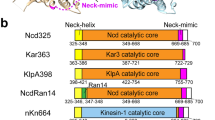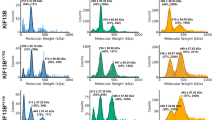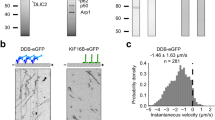Abstract
Work over the past two years has led to a breakthrough in our understanding of the molecular basis of the directionality of the kinesin motor proteins. This breakthrough has come first from the reversal of directionality of the kinesin-related motor Ncd, followed closely by the reversal of kinesin’s directionality and the finding that the Ncd ‘neck’ can convert Ncd or kinesin, which are intrinsically plus-end-directed microtubule motors, into a minus-end motor. These findings raise several outstanding questions, foremost, how does the neck function in motor directionality?
This is a preview of subscription content, access via your institution
Access options
Subscribe to this journal
Receive 12 print issues and online access
$209.00 per year
only $17.42 per issue
Buy this article
- Purchase on Springer Link
- Instant access to full article PDF
Prices may be subject to local taxes which are calculated during checkout


Similar content being viewed by others
References
Bloom, G. S. & Endow, S. A. Motor proteins 1: kinesins. Protein Profile 2, 1109–1171 (1995).
Hirokawa, N. Kinesin and dynein superfamily proteins and the mechanism of organelle transport . Science 279, 519–526 (1998).
Sellers, J. V. & Goodson, H. V. Motor proteins 2: myosin. Protein Profile 2, 1323–1423 (1995).
Yang, J. T., Laymon, R. A. & Goldstein, L. S. B. A three-domain structure of kinesin heavy chain revealed by DNA sequence and microtubule binding analyses. Cell 56, 879–889 ( 1989).
Yang, J. T., Saxton, W. M., Stewart, R. J., Raff, E. C. & Goldstein, L. S. B. Evidence that the head of kinesin is sufficient for force generation and motility in vitro. Science 249, 42–47 ( 1990).
Chandra, R., Salmon, E. D., Erickson, H. P., Lockhart, A. & Endow, S. A. Structural and functional domains of the Drosophila ncd microtubule motor protein. J. Biol. Chem. 268, 9005–9013 ( 1993).
Sablin, E. P. et al. Direction determination in the minus-end-directed kinesin motor ncd. Nature 395, 813– 816 (1998).
Kozielski, F. et al. The crystal structure of dimeric kinesin and implications for microtubule-dependent motility. Cell 91, 985–994 (1997).
Sheetz, M. P. Motor and cargo interactions. Eur. J. Biochem. 262, 19–25 (1999).
Endow, S. A. Microtubule motors in spindle and chromosome motility. Eur. J. Biochem. 262, 12–18 ( 1999).
Svoboda, K., Schmidt, C. F., Schnapp, B. J. & Block, S. M. Direct observation of kinesin stepping by optical trapping interferometry . Nature 365, 721–727 (1993).
Hunt, A. J., Gittes, F. & Howard, J. The force exerted by a single kinesin molecule against a viscous load. Biophys. J. 67, 766– 781 (1994).
Svoboda, K. & Block, S. M. Force and velocity measured for single kinesin molecules. Cell 77, 773– 784 (1994).
Meyhöfer, E. >& Howard, J. The force generated by a single kinesin molecule against an elastic load. Proc. Natl Acad. Sci. USA 92, 574–578 (1995).
Kojima, H., Muto, E., Higuchi, H. & Yanagida, T. Mechanics of single kinesin molecules measured by optical trapping nanometry. Biophys. J. 73, 2021–2022 (1997).
Howard, J., Hudspeth, A. J. & Vale, R. D. Movement of microtubules by single kinesin molecules . Nature 342, 154–158 (1989).
Kull, F. J., Sablin, E. P., Lau, R., Fletterick, R. J. & Vale, R. D. Crystal structure of the kinesin motor domain reveals a structural similarity to myosin. Nature 380, 550–555 (1996).
Sack, S. et al. X-ray structure of motor and neck domains from rat brain kinesin . Biochemistry 36, 16155– 16165 (1997).
Sablin, E. P., Kull, F. J., Cooke, R., Vale, R. D. & Fletterick, R. J. Crystal structure of the motor domain of the kinesin-related motor ncd. Nature 380, 555– 559 (1996).
Gulick, A. M., Song, H., Endow, S. A. & Rayment, I. X-ray crystal structure of the yeast Kar3 motor domain complexed with Mg-ADP to 2.3 Å resolution. Biochemistry 37, 1769– 1776 (1998).
Hurd, D. D. & Saxton, W. M. Kinesin mutations cause motor neuron disease phenotypes by disrupting fast axonal transport in Drosophila . Genetics 144, 1075– 1085 (1996).
Walker, R. A., Salmon, E. D. & Endow, S. A. The Drosophila claret segregation protein is a minus-end directed motor molecule. Nature 347, 780–782 (1990).
McDonald, H. B., Stewart, R. J. & Goldstein, L. S. B. The kinesin-like ncd protein of Drosophila is a minus end-directed microtubule motor. Cell 63, 1159–1165 (1990).
Endow, S. A. in Guidebook to the Cytoskeletal and Motor Proteins (eds Vale, R. & Kreis, T.) 403–408 (Oxford Univ. Press, Oxford, 1999).
Stewart, R. J., Thaler, J. P. & Goldstein, L. S. B. Direction of microtubule movement is an intrinsic property of the motor domains of kinesin heavy chain and Drosophila ncd protein. Proc. Natl Acad. Sci. USA 90, 5209–5213 (1993).
Hirose, K., Lockhart, A., Cross, R. A. & Amos, L. A. Nucleotide-dependent angular change in kinesin motor domain bound to tubulin . Nature 376, 277–279 (1995).
Hoenger, A., Sablin, E. P., Vale, R. D., Fletterick, R. J. & Milligan, R. A. Three-dimensional structure of a tubulin-motor-protein complex. Nature 376, 271–274 (1995).
Kikkawa, M., Ishikawa, T., Wakabayashi, T. & Hirokawa, N. Three-dimensional structure of the kinesin head-microtubule complex. Nature 376, 274–277 ( 1995).
Hirose, K., Lockhart, A., Cross, R. A. & Amos, L. A. Three-dimensional cryoelectron microscopy of dimeric kinesin and ncd motor domains on microtubules. Proc. Natl Acad. Sci. USA 93, 9539–9544 (1996).
Arnal, I., Metoz, F., DeBonis, S. & Wade, R. H. Three-dimensional structure of functional motor proteins on microtubules. Curr. Biol. 6, 1265–1270 ( 1996).
Henningsen, U. & Schliwa, M. Reversal in the direction of movement of a molecular motor. Nature 389, 93–96 (1997).
Case, R. B., Pierce, D. W., Hom-Booher, N., Hart, C. L. & Vale, R. D. The directional preference of kinesin motors is specified by an element outside of the motor catalytic domain. Cell 90, 959–966 ( 1997).
Endow, S. A. & Fletterick, R. J. Reversing a ‘backwards’ motor. BioEssays 20, 108– 112 (1998).
Endow, S. A. & Waligora, K. W. Determinants of kinesin motor polarity. Science 281, 1200– 1202 (1998).
Okada, Y. & Hirokawa, N. A processive single-headed motor: kinesin superfamily protein KIF1A. Science 283, 1152–1157 (1999).
Okada, Y., Yamazaki, H., Sekine-Aizawa, Y. & Hirokawa, N. The neuron-specific kinesin superfamily protein KIF1A is a unique monomeric motor for anterograde axonal transport of synaptic vesicle precursors. Cell 81, 769–780 ( 1995).
Crevel, I. M.-T. C., Lockhart, A. & Cross, R. A. Kinetic evidence for low chemical processivity in ncd and Eg5. J. Mol. Biol. 273, 160– 170 (1997).
Block, S. M. Kinesin: what gives? Cell 93, 5– 8 (1998).
Hirose, K., Cross, R. A. & Amos, L. A. Nucleotide-dependent structural changes in dimeric NCD molecules complexed to microtubules. J. Mol. Biol. 278, 389–400 (1998).
Hirose, K., Löwe, J., Alonso, M., Cross, R. A. & Amos, L. A. Congruent docking of dimeric kinesin and ncd into three-dimensional electron cryomicroscopy maps of microtubule-motor ADP complexes. Mol. Biol. Cell 10, 2063– 2074 (1999).
Naber, N., Cooke, R. & Pate, E. Binding of ncd to microtubules induces a conformational change near the junction of the motor domain with the neck. Biochemistry 36, 9681–9689 (1997).
Morii, H., Takenawa, T., Arisaka, F. & Shimizu, T. Identification of kinesin neck region as a stable α-helical coiled coil and its thermodynamic characterization. Biochemistry 36, 1933–1942 (1997).
Vale, R. D. & Fletterick, R. J. The design plan for the kinesin motors. Annu. Rev. Cell Dev. Biol. 13, 745 –777 (1997).
Sack, S., Kull, F. J. & Mandelkow, E. Motor proteins of the kinesin family. Structure, variations and nucleotide binding sites. Eur. J. Biochem. 262, 1–11 (1999).
Thrower, D. A., Jordan, M. A., Schaar, B. T., Yen, T. J. & Wilson, L. Mitotic HeLa cells contain a CENP-E-associated minus end-directed microtubule motor. EMBO J. 14, 918–926 (1995).
Wood, K. W., Sakowicz, R., Goldstein, L. S. B. & Cleveland, D. W. CENP-E is a plus end-directed kinetochore motor required for metaphase chromosome alignment. Cell 91, 357– 366 (1997).
Wordeman, L. & Mitchison, T. J. Identification and partial characterization of mitotic centromere-associated kinesin, a kinesin-related protein that associates with centromeres during mitosis. J. Cell Biol. 128, 95–105 ( 1995).
Schaar, B. T., Chan, G. K. T., Maddox, P., Salmon, E. D. & Yen, T. J. CENP-E function at kinetochores is essential for chromosome alignment. J. Cell Biol. 139 , 1373–1382 (1997).
Lupas, A., Van Dyke, M. & Stock, J. Predicting coiled coils from protein sequences. Science 252, 1162–1164 (1991).
Romberg, L., Pierce, D. W. & Vale, R. D. Role of the kinesin neck region in processive microtubule-based motility. J. Cell Biol. 140, 1407– 1416 (1998).
Howard, J. The movement of kinesin along microtubules. Annu. Rev. Physiol. 58, 703–729 ( 1996).
Tripet, B., Vale, R. D. & Hodges, R. S. Demonstration of coiled-coil interactions within the kinesin neck region using synthetic peptides. J. Biol. Chem. 272, 8946–8956 ( 1997).
Carr, C. M. & Kim, P. S. A spring-loaded mechanism for the conformational change of influenza hemagglutinin. Cell 73, 823–832 (1993).
Hackney, D. D. Evidence for alternating head catalysis by kinesin during microtubule-stimulated ATP hydrolysis. Proc. Natl Acad. Sci. USA 91, 6865–6869 (1994).
Hancock, W. O. & Howard, J. Processivity of the motor protein kinesin requires two heads. J. Cell Biol. 140, 1395–1405 (1998).
Young, E. C., Mahtani, H. K. & Gelles, J. One-head kinesin derivatives move by a nonprocessive, low-duty ratio mechanism unlike that of two-headed kinesin. Biochemistry 37, 3467–3479 ( 1998).
Berliner, E., Young, E. C., Anderson, K., Mahtani, H. K. & Gelles, J. Failure of a single-headed kinesin to track parallel to microtubule protofilaments. Nature 373, 718–721 (1995).
Ray, S., Meyhöfer, E., Milligan, R. A. & Howard, J. Kinesin follows the microtubule’s protofilament axis. J. Cell Biol. 121, 1083–1093 (1993).
Vale, R. D. & Toyoshima, Y. Y. Rotation and translocation of microtubules in vitro induced by dyneins from Tetrahymena cells . Cell 52, 459–469 (1988).
Wells, A. L. et al. Myosin VI is a myosin that moves backwards. Nature 401, 505–508 ( 1999).
Acknowledgements
This work was supported by a grant from the NIH. The figures were prepared by A. J. Kim.
Author information
Authors and Affiliations
Corresponding author
Rights and permissions
About this article
Cite this article
Endow, S. Determinants of molecular motor directionality. Nat Cell Biol 1, E163–E167 (1999). https://doi.org/10.1038/14113
Issue Date:
DOI: https://doi.org/10.1038/14113
This article is cited by
-
Anchoring geometry is a significant factor in determining the direction of kinesin-14 motility on microtubules
Scientific Reports (2022)
-
A rice class-XIV kinesin enters the nucleus in response to cold
Scientific Reports (2018)
-
Structural basis of small molecule ATPase inhibition of a human mitotic kinesin motor protein
Scientific Reports (2017)
-
The non-processive rice kinesin-14 OsKCH1 transports actin filaments along microtubules with two distinct velocities
Nature Plants (2015)
-
Clustering of a kinesin-14 motor enables processive retrograde microtubule-based transport in plants
Nature Plants (2015)



